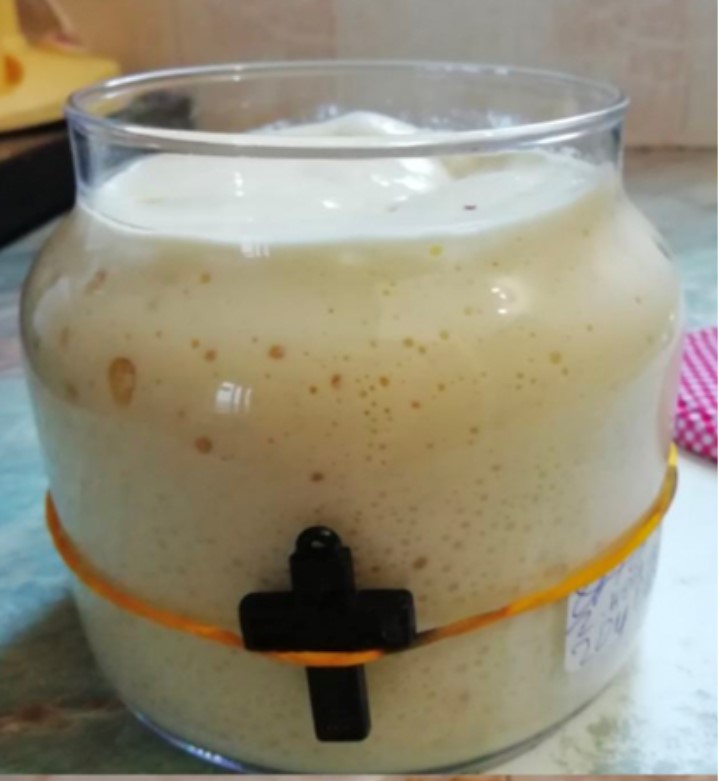Serbian Breads

Sacred, natural “starter bread.” Photo courtesy, and with thanks to Father Stefan Đorić.
The Serbian Orthodox religion and its people, dating back seven hundred years, have a unique identity shaped by the aroma of delicious food, the warmth of close-knit families, the vibrant Serbian music, and the spiritual presence of the church. These customs uphold timeless historical and liturgical traditions, with bread portraying a significant role.
Ask any Serb, and they will tell you—nothing compares to waking up in their home to the warm, irresistible scent of freshly baked bread. For many, it’s a nostalgic journey back to simpler times, where the sight of a mother or grandmother kneading dough in the kitchen was a familiar, and comforting ritual. As a child, the type of bread made never mattered; the heavenly aroma filling the home created a sense of warmth and belonging that lingered in memory.
In the villages and rural areas of the Kingdom of Yugoslavia, bread was an important and fundamental mark of hospitality. Offering a slice of bread was a gesture of welcoming someone into one’s home, and as a sign of respect. Bread represented an economic symbolism tied to the livelihood of many families who were farmers.
During the hardships of World War II, bread emerged as a lifeline for the Serbian people, a testament to their strength and spirit. In times of scarcity, many tucked loaves into their coat pockets as they hid from the advancing forces of the Third Reich. More than just sustenance, bread also became a sign of unity and celebration, shared at births, weddings, and slavas. Adorned with intricate shapes and decorations, each loaf carrying robust cultural weight. Each embodied the regional heritage, as well as reflecting on the richness of one’s local customs. No meal was ever complete without it, and for centuries, bread remained an indispensable element at every Serbian table, a daily reminder of its enduring strength and cultural pride.
Serbian bread is and always will be, a captivating subject with its diverse varieties, each loaf conveying its own distinctive role. These include the Pogača, a flat, round, and slightly leavened bread; Božićna Česnica, a round Serbian Christmas Bread with a silver coin tucked inside, symbolizing prosperity and luck in the coming year; Slavski Kolač, a round, decorated bread made for one’s patron saint day(slava); Starinksa Proja, an old fashioned cornbread made with or without feta cheese and kajmak; Lepinja, a flat, thinner bread, and Prosphora, a holy bread made specifically for Divine Liturgy, originated from the Greek word Prosphora. Each of these breads carries an unparalleled story, adding to the richness of Serbian traditions.
Prosphora, to this very day, holds a most venerable place within the Serbian Orthodox Church. This leavened bread has been revered with the utmost respect. As the holy bread of the church, Prosphora represents the unity and shared faith within the Orthodox community. Across many cultures and religions, bread has long been associated as a profound symbol. One notable example is the Bible’s reference to Christ feeding five thousand people with only five loaves of bread and two fish. Prosphora, an essential element of the sanctified Eucharist, embodies the spiritual connection of the faithful. Its preparation and consumption have never been just rituals, but a spiritual experience that deepens the bond within the Orthodox community.
The Orthodox tradition of preparing the leavened Prosphora, played a pivotal role centuries ago in the schism between Catholics and Orthodox. This ancient practice, deeply woven into the fabric of Orthodox spirituality, was often entrusted to monks, priests, or elder women, underscoring its sacred significance. The making of Prosphora, mindfully prepared with blessed flour and holy water, has a long-standing tradition rooted in revered monasteries such as Saint Basil of Ostrog in Montenegro and the Orthodox monasteries on Mount Athos in Greece.
According to an older tradition, the sacred task of kneading and preparing the starter bread, if not tasked by a monk or priest was by a married woman in a state of cleanliness, after bathing and adorning herself in fresh garments. Despite discontinuing certain ancient rituals, leaven still remains preferred, whenever possible, over yeast. As the natural starter bread ferments and develops, it emits a tangy aroma, signaling the addition of more holy water and flour to nurture the yeast’s natural growth. This bread making process serves as a testament to its enduring liturgical legacy.
this article is very useful, thank you for making a good article